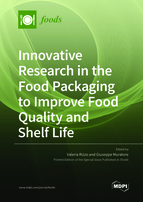Innovative Research in the Food Packaging to Improve Food Quality and Shelf Life
A special issue of Foods (ISSN 2304-8158). This special issue belongs to the section "Food Packaging and Preservation".
Deadline for manuscript submissions: closed (20 September 2021) | Viewed by 30267
Special Issue Editors
Interests: food packaging; food quality; phenols; shelf life; nutraceutics
Special Issues, Collections and Topics in MDPI journals
Special Issue Information
Dear Colleagues,
The increasing interest in reducing packaging wastes is becoming a burgeoning problem, just considering that food packaging alone contributes to almost 66% of total packaging wastes by volume in the world. On the other hand consumers judge the food quality on the basis of appearance and freshness but also using their awareness of the environmental implications of packaging. Following these two important aspects the attention on food packaging is huge, it is called to obtain a longer shelf life for a safer product, which is meanwhile rich in nutritional value and obtained in a friendly way for the environment.
Innovative research are widespread among scientists. From edible coatings to compostable packaging materials, from preservative additives to enrichment with essential oil, from assessing of new food technologies to improve the oldest. Innovation in food packaging are fundamental. Different solutions are being studied by researchers such as the utilization of agriculture waste to produce recyclable packaging or plant-based and compostable films.
All are involved. Government have to push industries to apply plastics with the highest percentage in recyclable, packaging is taxable, so it’s a cost. Industries must be more sustainable and reduce over-packaging finding little or no compromises to improve packaging sustainability without reducing shelf life. Recent concerns pointed out attention on packaging, packaging materials and shelf life therefore there is still a lot to work on.
Dr. Valeria Rizzo
Dr. Giuseppe Muratore
Guest Editors
Manuscript Submission Information
Manuscripts should be submitted online at www.mdpi.com by registering and logging in to this website. Once you are registered, click here to go to the submission form. Manuscripts can be submitted until the deadline. All submissions that pass pre-check are peer-reviewed. Accepted papers will be published continuously in the journal (as soon as accepted) and will be listed together on the special issue website. Research articles, review articles as well as short communications are invited. For planned papers, a title and short abstract (about 100 words) can be sent to the Editorial Office for announcement on this website.
Submitted manuscripts should not have been published previously, nor be under consideration for publication elsewhere (except conference proceedings papers). All manuscripts are thoroughly refereed through a single-blind peer-review process. A guide for authors and other relevant information for submission of manuscripts is available on the Instructions for Authors page. Foods is an international peer-reviewed open access semimonthly journal published by MDPI.
Please visit the Instructions for Authors page before submitting a manuscript. The Article Processing Charge (APC) for publication in this open access journal is 2900 CHF (Swiss Francs). Submitted papers should be well formatted and use good English. Authors may use MDPI's English editing service prior to publication or during author revisions.
Keywords
- Packaging
- Shelf life
- Food quality
Dear Colleagues,
The increasing interest in reducing packaging wastes is becoming a burgeoning problem. On the other hand, consumers judge the food quality on the basis of appearance and freshness but also using their awareness of the environmental implications of packaging. Following these two important aspects the attention on food packaging is huge, it is called to obtain a longer shelf life for a safer product, which is meanwhile rich in nutritional value and obtained in a friendly way for the environment.
Innovative research are widespread among scientists. From edible coatings to compostable packaging materials, from preservative additives to enrichment with essential oil, from assessing of new food technologies to improve the oldest. Innovation in food packaging are fundamental. Different solutions are being studied by researchers such as the utilization of agriculture waste to produce recyclable packaging or plant-based and compostable films. All are involved. Recent concerns pointed out attention on packaging, packaging materials and shelf life therefore there is still a lot to work on.
Dr. Valeria Rizzo
Dr. Giuseppe Muratore
Guest Editors








